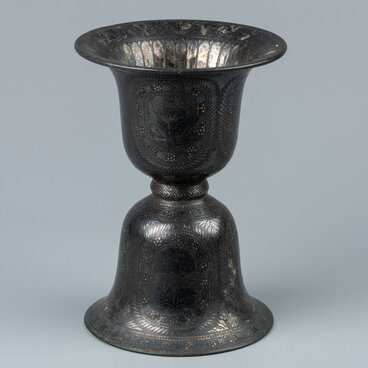The Samara Regional Art Museum displays a cylindrical Chinese vase with a wide mouth and a leg billowing downwards. The vase was for a long time kept in the collection of the Austrian entrepreneur Alfred von Vacano. It resembles in shape an ancient Chinese vessel gu. The gu is a type of vessels that was used both for drinking and for ritual offerings during the ancient Shang (1600 — 1046 BC) and Zhou (1046 — 256 BC) dynasties.
The colorful stylized floral ornament with an aster flower and the yellow mustard-colored glaze are characteristic of the décor of the Qianlong period (the second half of the 18th century). The yellow color of the vase symbolizes the feminine element Yin and the center of the world, that is, China itself. This color is also believed to be an attribute of the imperial family. Images of banana leaves on a vase are a popular motif in Chinese art. In addition, there is a signature on the vase: “Pin An from Huashan”.
It is worth noting that the word “vase” in Chinese is pronounced similar to “world”. Thus, vases are symbols of peace and harmony, the unsolved mysteries of the universe. The vase is also a sign of Buddha. A distinctive feature of the Chinese vase is the absence of sharp corners and straight, sharp lines. These vases embody tranquility and beauty.
China is the birthplace of porcelain. The beginning of porcelain production in China dates back to about the 6th — 7th centuries. After improvements in technologies and a careful selection of initial components, Chinese porcelain became distinguished by a special whiteness and thinness. At this time, the preference was given to monochrome glaze. In the 18th century, pink enamel paint was invented, which began to be widely used in combination with multicolored enamel. Porcelain products not only flooded the domestic market, but also turned into one of the main export items. Chinese vases, like all other porcelain items produced in China, have always been perceived by the Europeans as something exotic, mysterious, mystical and bewildering.
The colorful stylized floral ornament with an aster flower and the yellow mustard-colored glaze are characteristic of the décor of the Qianlong period (the second half of the 18th century). The yellow color of the vase symbolizes the feminine element Yin and the center of the world, that is, China itself. This color is also believed to be an attribute of the imperial family. Images of banana leaves on a vase are a popular motif in Chinese art. In addition, there is a signature on the vase: “Pin An from Huashan”.
It is worth noting that the word “vase” in Chinese is pronounced similar to “world”. Thus, vases are symbols of peace and harmony, the unsolved mysteries of the universe. The vase is also a sign of Buddha. A distinctive feature of the Chinese vase is the absence of sharp corners and straight, sharp lines. These vases embody tranquility and beauty.
China is the birthplace of porcelain. The beginning of porcelain production in China dates back to about the 6th — 7th centuries. After improvements in technologies and a careful selection of initial components, Chinese porcelain became distinguished by a special whiteness and thinness. At this time, the preference was given to monochrome glaze. In the 18th century, pink enamel paint was invented, which began to be widely used in combination with multicolored enamel. Porcelain products not only flooded the domestic market, but also turned into one of the main export items. Chinese vases, like all other porcelain items produced in China, have always been perceived by the Europeans as something exotic, mysterious, mystical and bewildering.






